Ecommerce SEO: How to Outrank Competitors and Boost Your CTR
With every passing year, online shopping becomes more popular. There are far more online shoppers than just a couple of years ago but there are also far more e-commerce shops. This means competition between these online retailers is becoming fierce.
According to a Business Insider article, as of January 2016, 40% of global e-commerce traffic was coming from search engines. In a recent consolidation of data, SmartInsights puts the figure at a staggering 43% of e-commerce traffic coming from Google search alone and Screenpages boldly states the percentage is 50 – 70%, if we include both organic and paid search traffic.
Whichever way you look at it traffic from search engines is of monumental importance for e-commerce businesses and that means so is SEO. Maintaining strong ranking positions and a high CTR should be the foundation of any e-commerce site’s digital marketing strategy.
Owing to the potential size and complexity of e-commerce sites, SEO is not always kept to the standard it should be. It isn’t just smaller businesses who are to blame, even large brands frequently leave much to be desired on the SEO front. This is partially due to the fact that the world of SEO moves so rapidly and it can be hard to maintain quality SEO health on a big site. However, as the Google search platform gets smarter, SEO, CRO and positive user experience are becoming increasingly synonymous. That means there is no excuse to neglect SEO, as it will work to directly drive traffic, sales and a positive reputation.
Many e-commerce sites are starting to take SEO more seriously and invest in it properly. This is good to see but the problem for online retailers is if e-commerce is growing 23% year on year and everyone is getter better at SEO, those coveted top positions will be hard to acquire.
If you were ever in any doubt as to how valuable high ranking positions are for your e-commerce site, simply head to Advanced Web Ranking’s cleaver CTR study tool where you can review the data for yourself. Below is a chart generated using the tool which displays CTR by position for March 2017:
When we analyse by average position the effect is even more stark:

CTR diminishes rapidly the lower your position, even within the first page of search results.
E-commerce site owners should not be disheartened by the task ahead of them because there are many expert e-commerce SEO techniques you can leverage to outrank your competitors and boost CTR.
The most crucial elements in e-commerce SEO are:
- Making sure your site uses HTTPS
- Using the correct keywords
- Carefully planning site architecture
- Ensuring all URLs are SEO friendly
- Correct implementation of on-page SEO
- Excellent content
- Essential technical SEO maintenance
- Speed
- Mobile optimisation
- High quality link building
HTTPS – make your site more secure
One of the biggest changes for e-commerce SEO in recent years has been the need for HTTPS sites. HTTPS is the secure version of HTTP. It makes your website more secure for users who are entering sensitive information, such as filling out personal details into a form or making a payment. It encrypts the data and adds an extra layer of protection. HTTPS usually uses one of the following protocols SSL (Secure Sockets Layer) or TLS (Transport Layer Security).
HTTPS is not just a nice additional security feature, Google has been quite aggressive in its encouragement of all websites to adopt HTTPS. It confirmed HTTPS is a ranking signal and despite some dissention among SEOs on that matter, e-commerce site owners should definitely still adopt HTTPs. In a bid to promote HTTPS usage Google Chrome now requires HTTPS, otherwise, the site will be labeled non-secure.
Clearly, HTTPS is important to SEO and site trust. If it matters to Google then the rest of us must pay attention. It is also useful for reassuring users as, when they access an HTTPS connection, a green padlock icon shows in the address bar and everyone loves a nice reassuring padlock when money could exchange hands:
When you request a HTTPS connection to a webpage, the website will initially send its SSL certificate to your browser. Acquiring an SSL certification is how you start the process of migrating your site to HTTPS. You can acquire various levels of security with these certificates and they vary in price. PluralSight offers a great list of reliable SSL certificate providers.
Don’t be intimidated by migrating to HTTPS. Search Engine Land offer a great guide for SEOs and an additional analysis of potential pitfalls to look out for.
Using the correct keywords
Keyword research should always come first and foremost in your strategy. Good initial keyword research will help you implement high quality on-page SEO that drives real results and provides a clear direction for your digital marketing strategy. This is no different for e-commerce site owners and keyword lists should never be chosen on intuition alone.
E-commerce site owners should obviously optimise for their product names and leading brands names but this is not sufficient by itself. Your competitors will be doing the same, so how can you gain an edge?
E-commerce site owners should carry out keyword research to find keywords which:
Have substantial search volume – if no one is searching for your keywords that means diminished traffic and potentially diminished conversions. You want to have a decent proportion of your keywords receiving substantial search volume. This shows there is demand for the product.

In the image above you can see the software reveals that while nail polish and nail varnish both have search volume around them, nail polish is the clear winner in terms of the amount of potential traffic it can bring in. Your products may go by various names and synonyms, so make your optimisation decision an informed one.
Are less competitive – e-commerce site owners need to gain a foothold in a competitive market place. To gain high rankings when your competitors are potentially more established in search means looking for opportunities. Less competitive keywords that still have decent search volume represent perfect gaps in the market. There is demand but your competition have failed to optimise for these terms so jump on them.
As e-commerce SEO becomes more competitive there are less ‘gaps in the market’. They still exist but you have to keep a keen eye on shifting trends in your market to catch them, before they are picked up by everyone in the industry. This is one of the many reasons why keyword research is not a one-off job. A successful online retailer must have their finger on the pulse of these shifting trends and demands in order to tweak SEO strategies to exploit these new opportunities.
Those highly-prized, high volume, low competition keywords are increasingly a rarity thanks to more e-commerce sites taking SEO seriously. This means e-commerce sites should look for a balance between optimising for high volume terms and lower volume but less competitive terms. This will help your site gain traction in search more easily in the beginning, while continuing to optimise and slowly gain visibility with the higher volume terms as well.
In the image below you can see nail polish has the highest volume but matte nail polish also has decent volume and less estimated competition. If that term suits your products, it might be the easier option to rank for, hence well worth including in your optimisation.

Are niche – niche terms do tend to have lower search volume but they can help showcase what is special or unique about your business. If you offer something few others do, you need to capitalise on that. You can always take on the task of creating the required demand using your social media strategies, content and PR strategies.
Niche items can often become desirable and receive high volume later if you create interest around them. If you optimised for these terms well and gained high ranking positions before anyone else, when there was low search volume and competition, then when the product becomes popular you will be able to reap the rewards. Take a look at the images below from Google trends. They reveal how interest has radically fluctuated for two niche terms: contour kit and mermaid makeup.
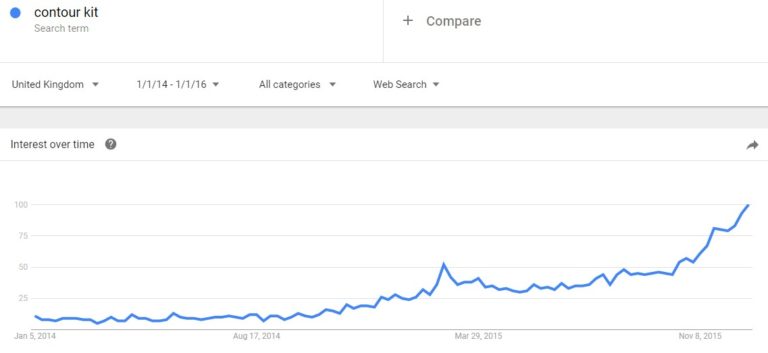
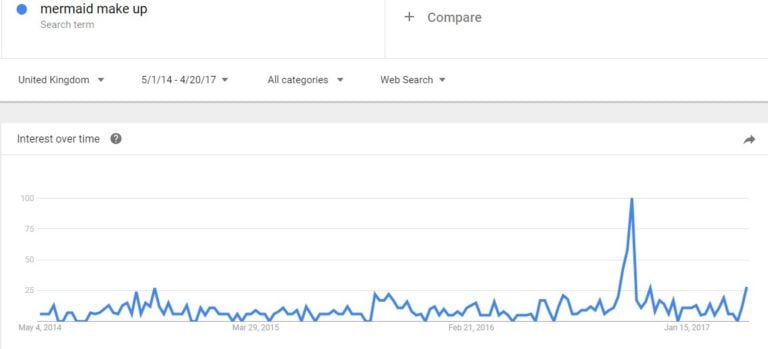
Interest rapidly grew for the former over a two-year period, going from niche to latest craze. The latter experienced slower growth but with a massive singular peak in interest, possibly due to a standalone, interesting content campaign.
Great SEO used as part of a wider promotional strategy can be very powerful. Who knows what the next bizarre fad will be.
Solve a problem or answer a question – in a competitive marketing place, finding the right keywords to gain good ranking positions and make an impact with your audience can be tough. That is why moving past your product terms to queries and problem solving terms can be a great asset. Terms like ‘buy Gucci shoes’ may have strong purchase intent and high volume but it will hard to gain a high position in search. By looking at informational terms, where users are clearing seeking an answer to a problem, you can use the educate, assist and promote strategy.
To do this you must find queries or solution seeking keywords then create and optimise content that solves the problem. You can educate the user, assist them and provide your product as a solution. Users will be grateful, you will gain a good reputation, generate interest and achieve a good ranking position for queries relevant to your industry. A perfect example would be, instead of trying to rank for just ‘buy Gucci shoes’, try optimising for terms like ‘shoes for narrow feet’.
How can e-commerce site owners discover these ideal keywords?
They are many excellent tools and techniques to help you discover the right keywords. The Google AdWords keyword planner is the perfect place to start. AdWords data can aid your SEO strategy and there is nowhere better to find accurate Google search data than Google’s own tools.
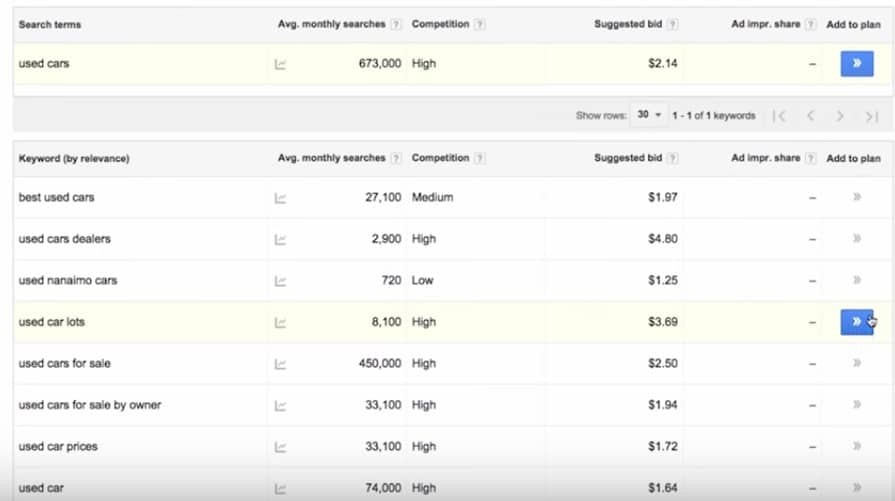
By inputting your starter keywords, such as your product names, into the planner you can quickly discover the monthly search volumes and related keywords to expand your list. You can also view estimated competition level and average estimated CPC. Even though this is related to paid search it can offer an additional clue to the level of competition you will face by attempting to rank for the term.
Another excellent tactic is to look at what your competitors are doing. If you have some strong competitors whose e-commerce sites are ranking well, take a look at their approach. Looking at their title tags and content gives a clue to what they hope to rank for. You can then use various software to see what they are actually ranking for. This can give great insight into potential opportunities and you can also analyse what your own site is already ranking for and implement greater optimisation for any that are advantageous.
Ahrefs and SEMrush are two fantastic pieces of software that can reveal which keywords your site and your competitors are already ranking for:

You should continually review your ranking positions for both the keywords you are ranking for and those you aim to rank for. SEMrush, Search Metrics, Stacked, Ahrefs, Advanced Keyword Rankings and Majestic SEO are examples of reputable SEO software you may want to invest in.
Now you have the start of a great keyword list but what about those niche and problem based keywords? Not to worry because there is plenty of excellent software to aid in that department as well. Even simply typing your product names into Google and looking at the suggested auto complete can create an idea of what relevant queries people are seeking. To discover niche relevant terms to your products, Amazon’s search auto complete can offer a more e-commerce orientated option.
There is a glut of fantastic SEO software to choose from that can help you find related keywords, niche terms, queries and problem solving keywords too. Below is an example from Mangools.

In the image above it provides related keywords to the searched term, search volume and estimated competition difficulty.

In the image above you can also see who is ranking in the top positions for your product terms by region. The is useful for then investigating how these competitors have optimised their own e-commerce sites.

By utilising ‘best for’ search experiments you can gather data about problem solving terms your audience are searching for. If you are having trouble ranking in the top position for your hair care products you could create content around ‘best hair for a long face’ and offer some of your products as a related solution.

You can also simply search for one of your product categories and discover relevant queries users are curious about. From the example above it would be fruitful to create an eye shadow cost guide to help your users.
You can also stumble across great long tail terms on forums, Reddit and Facebook groups.
Optimising for the right range of keywords is vital if you are to outrank your e-commerce competitors. Choosing the right balance of high search volume terms, low competition terms, problem solving terms, niche terms and answering queries is key to outmanoeuvring your more established competition.
Site Architecture
Before you embark on optimising for those keywords you should review your site architecture. This step is often missed on many websites and can create particular challenges for e-commerce websites.
Your site architecture forms the structure of your site and it should be both SEO friendly and helpful to users navigating the site. While you want to clearly segment your products for easy browsing by categories and subcategories you must ensure that desired products are quick to find.
The more links you have to navigate through from the homepage to reach the product page the less positive SEO juice that page is likely to experience. You want to make it as easy as possible for Google to crawl your site and find your most important products.
A good rule of thumb is to avoid unnecessary subcategories if they don’t serve a particular purpose and try to keep all products a maximum of three clicks from the homepage. This flowchart from Kissmetrics shows a possible site structure e-commerce sites can adopt:

Understandably this is a challenge for sites with a wide variety of products but quality site architecture is beneficial, therefore aim to keep at least your biggest sellers in easy reach.
Your SEO experts should ideally be heavily involved in your website build process to ensure elements like site architecture are carried out correctly, rather than building the site with no SEO consultation then having to fix problems later.
Site architecture is traditionally a pain to rectify once implemented poorly. This is because reorganising site architecture can involve re-structuring the URLs of categories and subcategories so that your site makes sense and flows in a sensible manner. Any SEO will tell you changing URLs is something to avoid like the plague.
Any positive SEO power that a URL acquired will be gone if you change it and although 301 redirects help, it can take time for websites to recover in rankings after a site architecture overhaul.
Breadcrumbs are another helpful ways to aid site navigation for your users while they are researching multiple products on your site. It makes site hierarchy obvious so they can quickly find where they are.

SEO-friendly URLs
Another problem that e-commerce websites frequently face is having non SEO-friendly URLs. It especially affects e-commerce sites due to mass upload of products and product pages having anonymous IDs in their URLs rather than the product name e.g. www.etheraldesigns/wallpaper/photo-5647 rather than www.etheraldesigns/wallpaper/photographic-wallpaper/red-elephant-print. The latter is a more SEO-friendly URL and more human-friendly, as it uses words rather than a page ID or product code.
Having your keywords and product name in the URL is a minor ranking factor and every little helps.
On-page SEO
Once you have your pristine keyword list and keyword strategy ready, sensible site architecture and URL structure, it is time to actually optimise those pages.
On-page optimisation should always be carefully planned to avoid cannibalisation. This occurs when you optimise too many pages for the same terms. This will not make your site more likely to rank but instead causes your own pages to fight one another for which should rank in Google search results for the term.
To correctly optimise your e-commerce site, include your target keywords in your title tags, H1s and content. This helps Google understand what your page is about and what search queries it will be relevant to.
Title tags remain one of the most important aspects of SEO and implementing high quality title tags should be one of the first things on your on-page SEO checklist. Title tags should be relevant to your industry. It is ideal if H1s reflect title tags and content includes several references to your keywords.
This does not mean sites should engage in keyword stuffing. A common mistake websites make with on-page SEO is having too few or too many keywords in their title tags and making their content spammy, in order to insert keyword references. The way to avoid this error is to constantly think about relevancy. What is your page about? It is the homepage, a category page, a product, a resource, a blog?
Below is the homepage title tag for the company Surfdome. It includes the brand name and exactly what they specialise in: clothing and equipment for beach and sea based activities, snow activities and skating. This is a sensible title tag.

Title tags can be used for more than outranking competitors, they can also directly aid CTR. The title tag is the first thing a user will see if they find your through Google search or any search engine. Not only do you want to be in a high position for their query, you also want them to click on your site rather than anyone else’s. While CTR does diminish with lower positions that does not mean humans always click the first result. You can steal traffic from higher ranking competitors if your title tag conveys a more relevant or enticing message. Consider the following example from Surfdome, this time on a main category page.
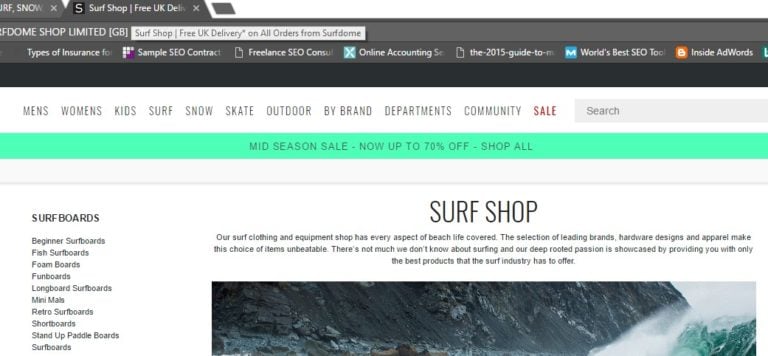
The first part of the title tag is relevant to the products and matches the H1 and they have also included mention of free UK deliveries for all orders. That is going to reduce the cost of purchase for all users in the UK and could be a major motivation to choose Surfdome’s products.
Below is an example of poor title tag optimisation from Irregular Choice:

Unless you already know that it is an online shoe retailer that title tag wouldn’t tell you much. Google would certainly struggle to tell from the title tag that the page is about shoes. If manually optimising every single product title tag is too time consuming, since you have a very large e-commerce site, use title tag templates to pull in product names and sensibly label your products. For category and subcategory pages it is always worth taking the time to review title tags and H1s.
Many e-commerce sites carry out on-page SEO and then forget about it. However, by constantly reviewing your own on-page SEO, rankings and those of your competitors you can catch more opportunities. Including offers like 20% off in title tags could be a good way to lure users away from the higher-ranking sites and if you noticed your rankings increasing for a particular term, review the on-page optimisation to see if you can improve it further.
Remember title tags do not have to be static, you can tweak them to reflect changing trends related to your product or category.
**Meta descriptions – **Now you know title tags, H1s and content are ranking factors, so what about meta descriptions. Unfortunately, meta descriptions are not a ranking factor but they are not useless. SEO is about ranking but it is also about building traffic to your website. CTR is just as important as rankings if not more important. After all high rankings alone do not aid your profit margin if nobody clicks through to the site to buy.
Meta descriptions, along with title tags are what users first see of your website in Google search results, they can therefore be used in much the same way to encourage users to click. Utilise these extra characters to give potential customers more detailed information about what your e-commerce store supplies.
Take a look at the following four meta descriptions for search results for the term designer tablecloths. Which do you think will drive better CTR?

The first is pretty good as it reassures the user they are buying from a trusted, well-known department store, they also know they can find top tips but sadly the character count has been made too long and the description has been truncated part way through the sentence.
The second description tells us about other related products they sell, which may be useful if you also need those products but not very compelling if you just really want a designer table cloth.
Both the later descriptions are strong as they are relevant to the search query and promise free deliveries if you spend over a certain amount.
**Internal linking – **Another useful element of on-page SEO is internal linking between different pages of your content. This will help Google crawl your site and see connections between your content. This also helps your content support each other e.g. linking successful blogs to products and vice versa. This is not just valuable for ranking but again it assists users to discover connected content on your website. They may have encountered an article page on your website while looking for a makeup tutorial and then can easily be led to the pages with the products featured in the tutorial to buy for themselves. While external links to your website bring better domain authority and ranking, internal linking should not be overlooked in your goal for superior e-commerce SEO.
Structure data mark-up – Marking up your website’s HTML with structured data can help Google better understand the structure of your page and the type of content it is.
While adding structured data mark-up is not directly a ranking factor it is still extremely valuable, especially for e-commerce sites. Adding structured data allows Google and other search engines to feature rich snippets in your listing within the search results.
Recipe review snippet:

Showtime snippet:

Watch the videos below from Google Webmasters for an introduction into structured data mark-up, the necessary information required in product mark-up and review mark-up.
Structured data introduction:
https://www.youtube.com/watch?v=_-rRxKSm2ic&list=PLEDEEE61C34CCF962&index=3
Having rich snippets in your search results listing has been shown, in many case studies, to increase CTR but despite Google showing rich snippets in over a third of results, only a small percent of sites have structured data mark-up.
This is a shame because rich snippets help your listings look better, take up more space in search and provide users with more information. You can mark-up price, availability, offers, images and more, all of which are an obvious advantage to e-commerce results.
Schema is a popular type of structured data developed in collaboration with Google, Yahoo and Bing. It offers a huge range of ways to mark up your website data and you can find the full list here.
While uptake of structured data has been slow, despite its benefits for CTR, it is actually quite simple to implement. There are many ways to add structured data to your site:
- You can manually code your structured data and insert it directly into your HTML if you feel up to the task. Schema.org provides excellent guides for the various mark-up structures.
- You can use Google’s handy structured data mark-up helper tool to generate the HTML code for you.
- There are a number of excellent plugins for structured data, such as All in One Rich Snippets for WordPress, which is one of the most popular.
- You can skip plugins and code altogether and use Google’s Data Highlighter tool, located in the Google Search Console. It should be noted that this would only highlight relevant data to Google search not Bing or Yahoo.
Structured data is a fantastic addition to the on-page SEO checklist to create more engaging listings for users. If you are unsure if your structured data mark-up has been implemented correctly you should test is with Google’s structured data testing tool.
Alt image tags – This is one of the most overlooked aspects of on-page SEO. E-commerce sites tend to have a large number of missing alt image tags because they tend to upload large numbers of products and their images en-masse and forget to bother with alt image tags. In addition to aiding the visually impaired understand an image, alt image tags or alternative attribute tags help Google understand what an image depicts and makes it more likely for the image to show in Google images search results. This is another way to drive traffic to your website if users prefer to perform research visually.
Excellent Content
Content touches every part of your digital marketing strategy and has become a core part of SEO. Without excellent content, on-page SEO can’t get off the ground. Content needs to do more than just contain your keywords, it also needs to be rich, insightful, useful and above all not thin or duplicated.
E-commerce sites are product focused and the desire to get large numbers of products listed on a website quickly can lead to neglected content. If a page is going to rank well it requires content, whether it is a homepage, category page or product page.
We noted earlier how the Surfdome website had some good title tags application compared to other sites but if we analyse their homepage we can see it severely lets them down. Not only does it lack an H1 but its content is very thin. Minimalist designs that focus on product imagery are aesthetically popular but do little for your SEO:

Here Urban Decay has opted for thin content on their lip brushes page:

Product pages on large e-commerce sites are often guilty of copying manufacturer descriptions but Google will still see this as duplicated and you cannot no index your product pages as they are the most important part of your website.
E-commerce sites need to embrace rich content both for SEO and to showcase their products in the best light and describe what is special about them.
Content can go far beyond simple product and category page descriptions. Once you have moved past the basic on-page SEO implementation side of content, it is time to develop a content marketing strategy.
Modern humans are addicted to absorbing content online and knowledgeable online retailers can exploit this to their advantage. As we pointed out during our discussion of keyword research, content can be a tool to enhance your SEO ranking by providing educational, problem solving content.
The truly wonderful thing about building a powerful content strategy is it will aid your SEO but also your social strategies, increase user engagement, help build links and create increased brand awareness. It’s a win, win situation if you hit on the right content formulae.
To discover what type of content you should develop to help your customers and promote your products you should start with a similar method to your keyword research. Google keyword planner tends to be better for researching wider topics, short tail terms with high volume but interesting or problem solving content tends to be long tail.
Third party SEO keyword software offers a better balance of short tail and long tail keyword and content discover. If we take the example of a cosmetics company, one of their USPs might be that they are cruelty free. They may already have a page optimised for cruelty free make up which explains their commitment and policy but they can capitalise on this further with their content strategy:

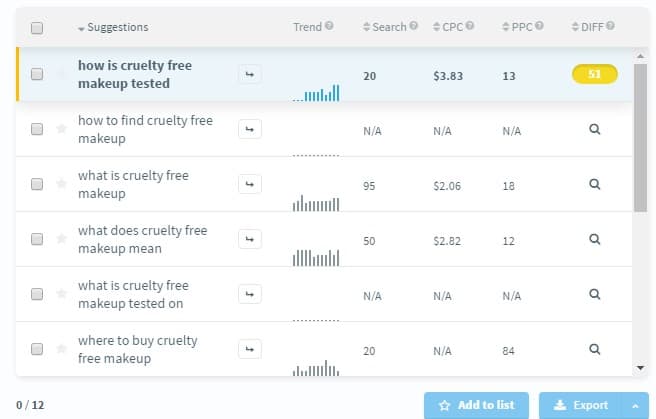
From the data above we can see it would be helpful for our target audience if we develop content around how cruelty free makeup is tested, what is cruelty free makeup, cruelty free makeup for sensitive skin etc. We already have the start of our content strategy. A great free tool for finding long-tail topics on almost any subject is Answer the Public. If you don’t currently have access to any paid third party keyword research software this is a very helpful tool.
E-commerce site owners can also look at successful bloggers in their niche who are already ranking well. Bloggers create content for engagement and interest and there are bloggers in almost every industry you can think of so you won’t need to look very far to gather inspiration.

There is even software developed specifically for finding content that has already been successful. Whether you judge success by the number of links an article receives or how much it is shared on social you can find it by searching topics on platforms like Buzzsumo.
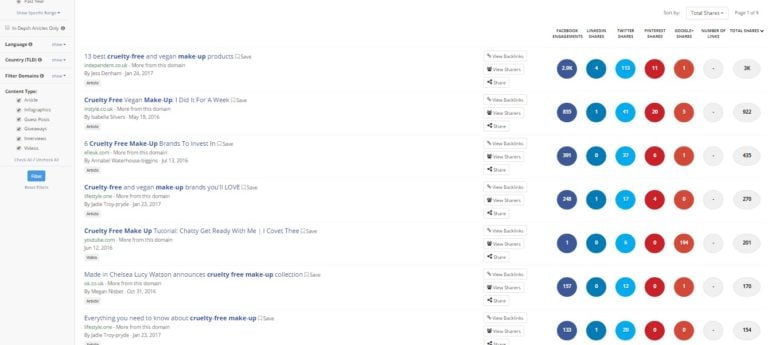
Naturally content does not need to stop at articles. Videos, image tutorials, reviews, infographics, quizzes and interactive mini games are all content that attract users. If you are worried your topic has been done to death, portraying it in a new, more entertaining format can be the key to success.
Technical SEO
Content creation is creative, fun and great for SEO but we must not forget the value of technical SEO.
When it comes to technical SEO for e-commerce sites one of the most important tasks is to make sure pages with thin content, such as ‘sorting function’ pages are not indexed by search engines.
Sorting pages are pages, typically found on e-commerce sites, which serve the purpose of sorting data for browsing users. If a user can filter products on your site to refine their search by colour or brand or any criteria this produces a filter page. These pages are useful to humans but not search engines. It simply means you have a large number of pages being indexed that have no SEO value.
Other pages you may want to no index are pagination pages if you have multiple pages worth of products in a category. You can prevent Google from indexing pages on your site by a number of methods.
You can add the pages as no index in your robots file.

Alternatively, you can set URL parameters in your Google search console. This is useful for e-commerce sites as you can easily prevent your checkout pages, order pages, pagination pages and any others from being crawled by Google. You could specific that all URLs containing sort or checkout are not indexed. Shoutmeloud shows an example of their URL parameter settings below:

While this prevents Google from crawling the pages, if they have already been crawled they may remain in Google’s index. Setting the necessary pages as no index in your website settings is a better way to prevent the pages from being initially crawled. You can use the following code but some sites like WordPress give you an easy no index option on all pages and posts.
E-commerce websites frequently fall foul of another big SEO problem and that is duplicate content. This can be caused by products placed in multiple categories or new URLs being generated for every product option e.g. size and colour variations. Google’s Panda algorithm is not a fan of duplicate content since it offers no value to users. Sadly, it seems little consideration of e-commerce site dynamics went into this consideration. Set your canonical tags up correctly to show which version Google should pay attention to.
It is usually best to avoid putting products in multiple categories to avoid the issue and ensure good site architecture.
Retail giant Next have a good site structure for dealing with this problem. While users have the option to select different colours, sizes and patterns for a dress type the URL does not change, hence no risk of duplicate content or extra indexed pages.


It is only let down by the fact that the URL is not very SEO friendly as it has a page ID not a linguistic URL.
Proper implementation of canonicals are important for every type of site not just e-commerce, to ensure all versions of your site redirect to your preferred version e.g. https://www.example.com rather than having multiple indexed versions of https://www.example.com and https://example.com
If you are concerned Google is indexing pages it shouldn’t be you can always check how many pages are being indexed in the Google search console.
As well as performing SEO technical audits with your preferred third party software (such as Screaming Frog, SEO Doctor or Advanced Web Ranking, etc) to find problems like missing alt image tags and broken links, the Google search console itself is a marvellous tool for maintaining technical SEO health for your e-commerce website. It is free to use, unlike most third-party software and can tell you a great deal. It can highlight crawl errors, issues with your sitemap, structured data, blocked resources on site, who is linking to your site and even HTML improvements in case you have duplicate title tags, meta descriptions or H1s.
https://www.youtube.com/watch?v=SoxU5kz15Kc
By regularly reviewing the Google search console you can help keep your e-commerce site in tip top working order for search engines and users. Adding a sitemap to your Google search console can help Google crawl your site efficiently and GSQI offer expert advice on how to keep sitemaps clean on large websites.
Speed
If you have followed our e-commerce SEO advice so far your site should be in a sparkling condition but it could still be subject to a nasty issue that could make all your hard work for nought: speed. If your site isn’t fast it will likely fail. Big beautiful images, videos and fascinating interactive features are great for e-commerce sites…..until they slow down your website, then they are a disaster. E-commerce websites are again especially vulnerable because of their potential size and additional features but slow sites damage your SEO and your user experience. Speed is a ranking factor and according to Adobe research 39% of people will stop engaging with a website if it takes too long to load.
To keep e-commerce sites fast ensure that you compress your images to suitable sizes, add leverage browser caching code and if necessary minimise CSS unless it damages user experience.
Run speed tests frequently for all devices and don’t forget to test your checkout system for speed.
To find out the speed of your website and for more tips on solving speed issues check your website in the Google page speed insights tool.
Mobile optimisation
Mobile optimisation should go beyond just having a responsive site. On e-commerce websites, you want to create an attractive, easy to read layout and make mobile conversion easy.
38% of people will leave a website if they find the layout unattractive and conversion on mobile devices continue to fall far behind conversion on desktop despite the rise in mobile browsing. Continually test mobile experience on your e-commerce shop to find pitfalls and room for improvement. 70% of e-commerce site users rank the ability to zoom in on product images among their top priorities for deciding whether to purchase and this is even more important for mobile users on a smaller screen. For more tips on designing e-commerce sites for mobile take a look at our recent article.
Link building
Recent studies from Search Metrics and Moz have revealed that link building may be slowly reducing in importance for ranking factors while content relevance continues to grow. Many SEOs will be relieved as Google’s continued crack down on link schemes has meant link building has become one of the most challenging parts of SEO. Even when your content is truly deserving of a link it won’t automatically receive one and site owners have become terrified of giving links away for fear of losing their own SEO power or being penalised.
However, until Google completely alters its algorithms, link building remains a primary ranking factor. Links aid your site domain authority and tell Google that you are a reputable source. So how can e-commerce sites build links to aid their SEO? Well in the past reaching out to bloggers to review your products was a perfect method. Now you must be very careful that you are not penalised for this behaviour. A rash of sites exchanging free products for reviews and links by bloggers led to a sever crack down by Google last year.
Despite this not so small hiccup your industry bloggers are still an ideal resource. Instead of giving free products for links why not offer to write a useful, educational article for their blog with an authorship link back to your site? PR campaigns and content campaigns can also generate links if what you have to say is interesting. Product how to guides and tutorials are often interesting to your target audience and if you promote them properly e.g. through social marketing and PPC other sites will link to you because you deserve it.
This method is the most honest way to get links but it is not very fast. In addition to reaching out to bloggers and creating great linkable content you can also look for existing content that may have broken links. By pointing this out to site owners and offering your own site as a relevant replacement link you are more likely to succeed.
Analysing your competitor backlinks is another excellent tactic. If these sites linked to your competitors they might be equally willing to link to you. Many varieties of software offer the opportunity to explore your competitor’s backlinks, including SEMrush, Ahrefs and Web SEO Analytics.

Managing your own backlinks is equally important if you want to keep your link profile clean and penalty free. Be sure to regularly review your backlinks in the Google search console and disavow any spam. If you have never disavowed links before, check out the tutorial video below:
https://www.youtube.com/watch?v=aeJSteNk-x0
Send your e-commerce site to the top
Now you should have the knowledge you need to take your e-commerce site from basic optimisation to an advanced website with a clear SEO strategy ready to outrank competitors and increase your CTR.
For a few extra tips we recommend remembering to cross-sell and up-sell
